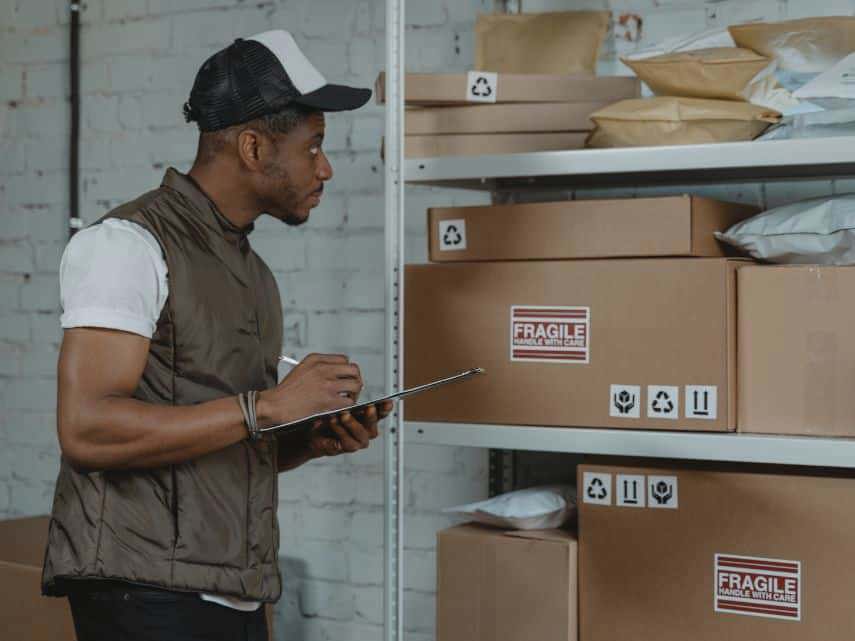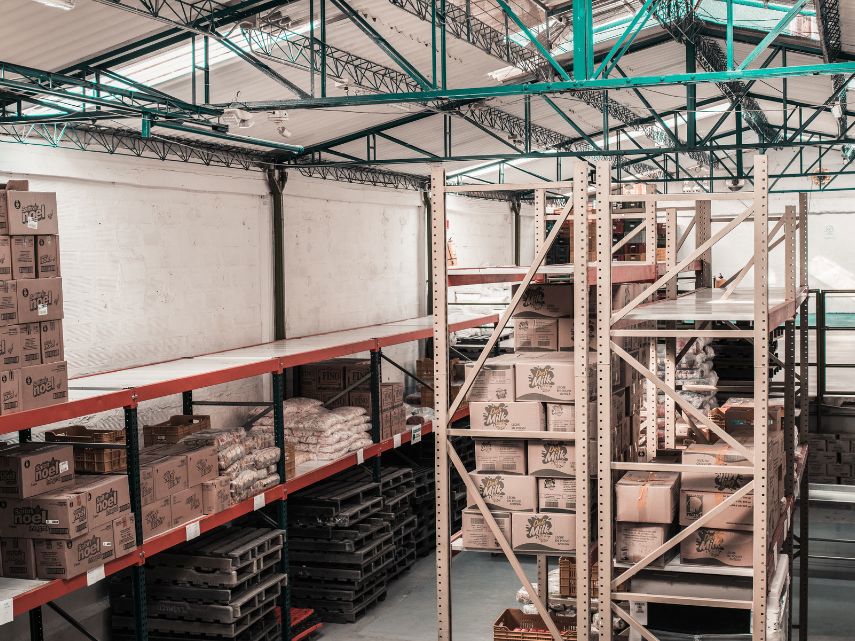
Order picking isn’t hard when you’ve got a fully optimised system in place. You’ll be able to pick more orders, more accurately, in less time. And that's the goal. But to get there, we must first break down warehouse order picking into its separate processes and identify which steps can be improved.
 An optimised order picking system will eliminate excessive travel time and increase fulfilment speed.
An optimised order picking system will eliminate excessive travel time and increase fulfilment speed.
The benefits of an optimised warehouse order picking system
Optimising your warehouse order picking system is all about improving the overall ROI of your warehouse. You want to increase productivity and efficiency all while reducing total costs.
When done correctly, the order-picking tips in this list will help you:
- Minimise travel time between picking locations.
- Cut unnecessary steps out of the order-picking process.
- Implement the right equipment for your business.
- Process customer orders faster than before.
- Automate parts of the picking process you were doing manually.
Ultimately, these order-picking tips will save you time and money that can be reinvested into other areas – such as growing your business.
10 key warehouse order picking tips for SMEs
Fulfilment is an essential part of inventory management for any product-based business.
And fulfilment begins with order picking.
The following warehousing tips will enable you to fully optimise this first and crucial step of the order fulfilment process.
1. Optimise the layout of your warehouse
Travelling constitutes 50% of all order-picking activities in picker-to-parts systems, making it by far the most time-consuming activity.
We can infer, then, that minimising travel time greatly improves picking efficiency. This can be done in many ways, though not everything listed below will work for every warehouse.
Follow these tips to optimise the layout of your warehouse:
- Store frequently ordered products closer to the packing area, at eye level.
- Store rarely ordered products further away, above or below eye level.
- Don’t mix SKUs – if two products must share a location on the shelves, use bin dividers or stackable containers to keep them separated.
- Maximise storage space by installing adjustable shelving, bin dividers, and pallet racks.
- Keep aisles and shelves clean and clear of rubbish or debris.
Minimising travel time in the warehouse is one of the first things you should look at when improving your picking processes, as it typically costs nothing and can be implemented immediately.
 Redesigning the layout of your warehouse can simplify order picking and maximise storage space.
Redesigning the layout of your warehouse can simplify order picking and maximise storage space.
2. Pick items directly into their shipping packages
When analysing your picking processes, you may find some steps unnecessary.
For example, picking an order, placing it in a cart, taking it to the packing area, and then packing it into a box or parcel for shipment requires double handling of the product.
Many businesses can save a few minutes each day by picking items directly into the packages they’ll be shipped in. This makes it especially practical when using a batch or cluster order picking method, as it will reduce the risk of items from different orders getting mixed up.
Depending on the goods you sell, you may choose to add boxes or envelopes to your picking cart – or if you’re shipping a large crate of goods, simply leave the crate at the end of each aisle as you pick items directly into the crate.
3. Use a warehouse order-picking method that fits your business
The order-picking method you opt for will greatly impact your warehouse management productivity. It affects how fast you’re able to fulfil orders and how few picking errors are likely to occur.
To ensure an optimal order-picking method, consider the following factors:
- Warehouse size
- Order volume
- Time it takes to fulfil an order
- Risk of picking mistakes
- Time it takes to train employees
- Total cost of necessary tools and technologies
- Labour costs
Single or cluster order picking is ideal for small warehouses, warehouses with a low volume of daily orders, and businesses where picking accuracy and minimal costs are the main priority.
Conversely, batch, wave, and zone order picking methods are all better suited to larger warehouses, warehouses with a high volume of daily orders, and businesses where short fulfilment times are the main priority.
Many businesses prefer to combine picking methods – for example, batch-wave picking – to create a system that’s perfectly tailored for them.
4. Remain flexible and be prepared to shift picking methods
Businesses grow and technology evolves. Don’t let your picking methods stagnate as the world moves on around them.
A good way to prepare for growth is to identify the KPIs that will justify a change in systems.
For example, you may determine that the single order picking method will only be efficient until you hit 50 orders per day, at which point it would be prudent to switch to batch picking.
Identifying these milestones early on will help you make a timely switch before your old system is completely overwhelmed.
 Businesses can benefit from regularly auditing your current order picking processes and making changes to them as they're needed.
Businesses can benefit from regularly auditing your current order picking processes and making changes to them as they're needed.
5. Choose the right tools and equipment for picking orders
There are dozens of warehousing tools that can be used to reduce picking time and increase accuracy.
However, not every business needs a forklift or barcode scanners.
Here's a list of popular order-picking tools and who they're suitable for:
- Barcode scanners: Useful if you’re looking to reduce picking errors or connect your picking process to your inventory management software.
- Forklifts, lift trucks, and pallet jacks: If you regularly receive or store goods on pallets then investing in a machine to move them around can reduce weekly travel time by hours.
- Ladders and step stools: Keeping a ladder or step stool nearby will make it much simpler and safer to retrieve the goods you store in hard-to-reach locations. In a large warehouse with multiple elevated storage locations, it can be economical to store a ladder in each area – rather than carry the same one back and forth across the warehouse floor.
- Shelves, pallet racks, and A-frames: Storing products haphazardly can make it difficult to find what you’re looking for. That’s why manual storage solutions, such as shelves and pallet racks, are fundamental additions to most warehouses.
- Carousels and lift modules: Automated storage and retrieval machines, such as Vertical Lift Modules and Vertical Carousel Modules, allow you to maximise storage space while automating the picking process. As installation and equipment can be quite expensive, we recommend investing only if you can guarantee a positive ROI.
- Carts and hand trucks: If you stock a lot of small- and medium-sized goods, using a cart or hand truck to move them from their storage locations to the packing area can allow you to move a lot more stock in one go. This a great way to quickly reduce travel time in your warehouse.
- Reusable bins and bin dividers: Likewise, businesses selling products that fit into reusable plastic bins will greatly benefit from the economic storage and organisational improvements they offer. Many of these bins even come with dividers, so that you can store multiple products in one bin without them getting mixed up.
Knowing which equipment is suitable for your warehouse will prevent unnecessary spend on things that don’t contribute to more efficient fulfilment.
6. Increase picking efficiency with inventory management software
Using the right software is paramount to automating your warehouse order picking processes.
The more products you stock and orders you receive, the more complex inventory management becomes. To stay on top of it all, you should consider installing inventory management software.
For picking purposes, inventory management software can help by:
- Automatically generating pick lists and organising them by SKU, location, and more.
- Enabling real-time stock level changes that speed up stocktakes.
- Synchronising technologies, such as mobile scanners, with inventory records.
- Filtering products and orders by name, supplier, location, status, and product code.
- Integrating with your online sales channels, such as Shopify and Amazon.
To ensure you pick the right inventory management software for your business size, you’ll need to forecast the ROI of switching to a new system. Remember to include training costs, implementation costs, and time saved automating processes.
7. Automate your picking processes
A study conducted by Zebra Technologies found that 61% of decision-makers plan to introduce partial automation to their warehouses.
Let’s look at some of these warehouse automation tools now:
- Mobile scanners. Barcode scanners can come in handy at both the picking and packing stages. They require products or product bins to bear a unique barcode that can be scanned by pickers as they pick the items. The scan-and-pick process minimises the opportunities for human errors and can help guide pickers to the right locations by displaying them alongside the SKUs.
- Pick-to-light systems. Pick-to-light technology is designed to improve picking accuracy and efficiency and lower labour costs by illuminating (literally) the most economic picking path. Using an alphanumeric display (typically, LED lights), a picker can easily find the SKUs they need simply by scanning a barcode.
- Voice picking equipment. Voice-directed picking technologies use a combination of real-time communication and interactive voice response to boost accuracy and productivity in a warehouse. Pickers receive picking instructions through a voice-picking device – often a headset – and confirm the items they pick using verbal communication.
While equipment like these can improve efficiency for some warehouses, they’re not suitable for every business out there. For example, if you’re running a small warehouse with only 15 unique SKUs and an average of 10 orders per day, then upgrading to a more high-tech system may prove a costly waste of time.
Make sure you understand exactly what benefits an automated system can give to your warehouse before making any major investments.
 Automating your order picking systems can result in shorter delivery times and happier customers.
Automating your order picking systems can result in shorter delivery times and happier customers.
8. Perform regular stocktakes
Stocktaking enables you to maintain an accurate track of the physical stock you have on hand.
It also highlights any significant discrepancies between your records and your actual stock, and allows you to measure how well different products are performing.
Using sophisticated warehouse inventory management software will help to improve the speed and accuracy of your stocktakes. But there are more steps you can take to optimise the process.
Here are five quick order-picking tips for performing stocktakes:
- Schedule stocktakes of your complete inventory to be performed at least annually – this is a tax law in some countries.
- Freeze receiving and shipping while performing stocktakes to prevent changes from occurring halfway through.
- Recount any products that have a discrepancy, but only perform multiple recounts on high-value items.
- Investigate major discrepancies; finding the root cause of missing (or extra) stock can help prevent future inaccuracies.
Although full warehouse stocktakes should take place at least once per year, you can also benefit from performing stocktakes of specific SKUs, product locations, or product types on an as-needed basis.
9. Minimise touchpoints
Touchpoints – parts of the order-picking process that involve human interaction – may be significantly reduced to minimise picking times.
“It is certain that [the supply chain] can become more streamlined by reducing the number of touch points and costly product handling.”
- Dave Wendland, VP of Strategic Relations at Hamacher Resource Group Inc., via Forbes
Here are a few quick tips for minimising touchpoints in your warehouse:
- Shorten pathways between storage locations and the packing area.
- Wait until pallets or truckloads are near maximum capacity before moving them.
- Optimise your delivery and receiving processes by incorporating contactless collection/drop-off.
- Consider switching from single order picking to batch or cluster picking.
The less double handling of products you can manage, the faster you’ll be able to fulfil multiple orders.
 Minimising the number of touchpoints in your fulfilment process will save you time and reduce human errors.
Minimising the number of touchpoints in your fulfilment process will save you time and reduce human errors.
10. Take the time to properly train new employees
Research conducted by the University of Moratuwa found that training warehouse workers was a top-three factor affecting the efficiency of warehouse picking.
Proper employee training can prevent picking mistakes, familiarise pickers with picking locations (reducing total travel time), and create autonomy as workers gain a complete understanding of their role.
Here are some examples of warehousing processes your training programme should cover:
- Use of inventory management software or other digital tools that your workflows rely on.
- Physical operation of any tools and equipment, such as forklifts and mobile scanners, required to pick an order.
- Carrying out the various order-picking methods that you follow to fulfil orders.
- Health and safety protocols and contingency plans.
A great way to find out which parts of the job are confusing or difficult to learn is by simply asking your current warehouse staff. They’ll be able to inform you which processes could benefit from being included in a training programme, and which ones require little education to fully grasp.
